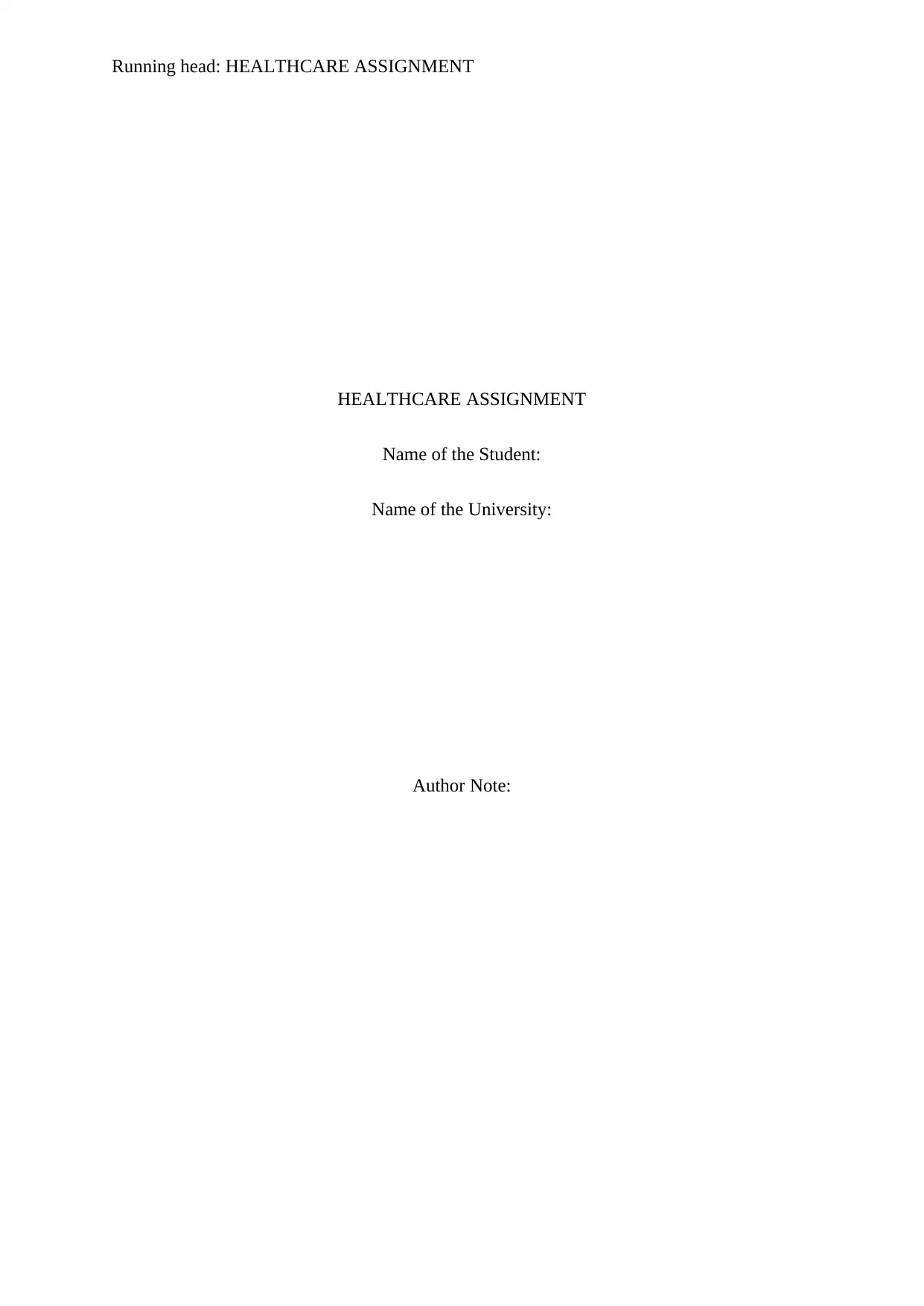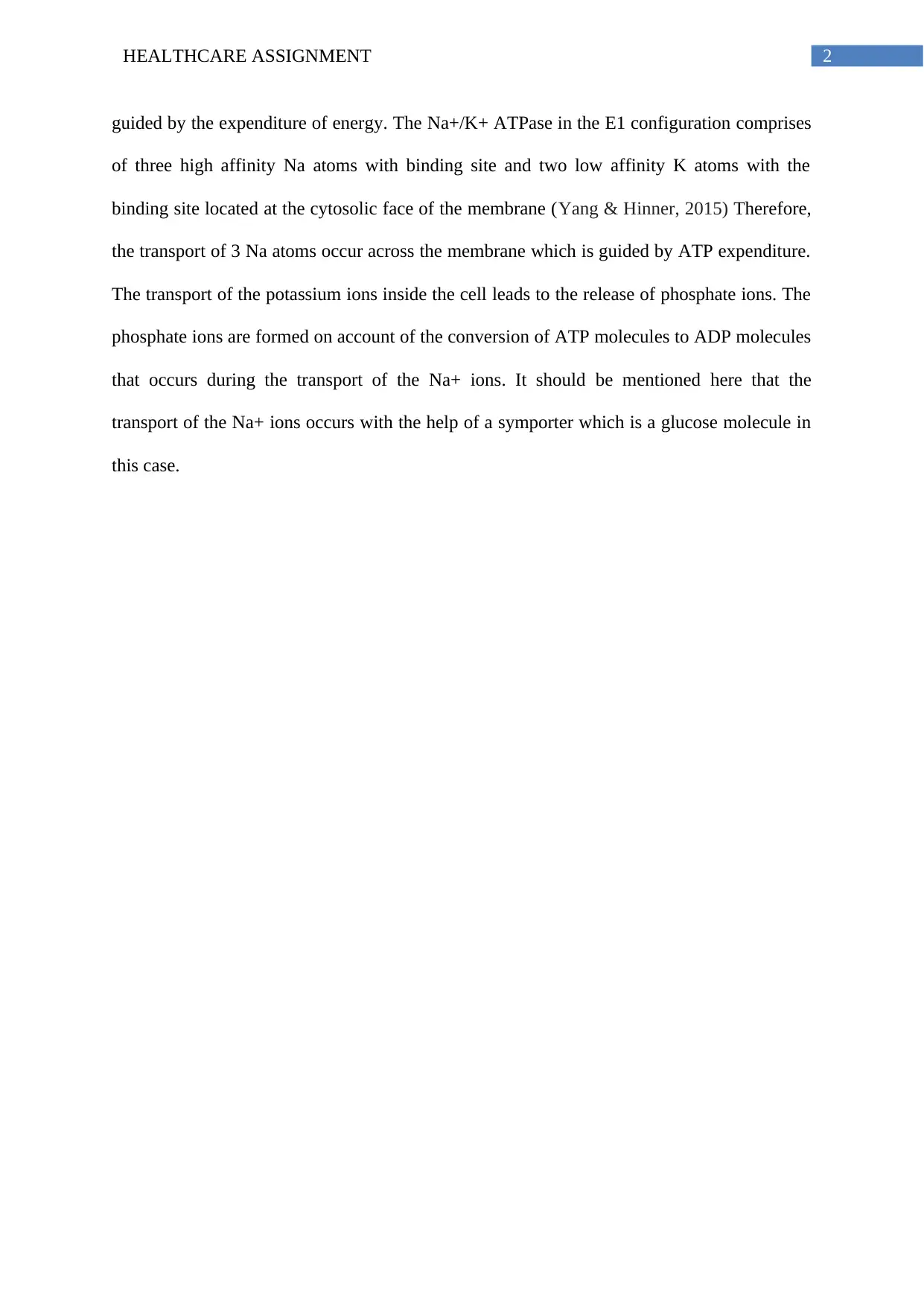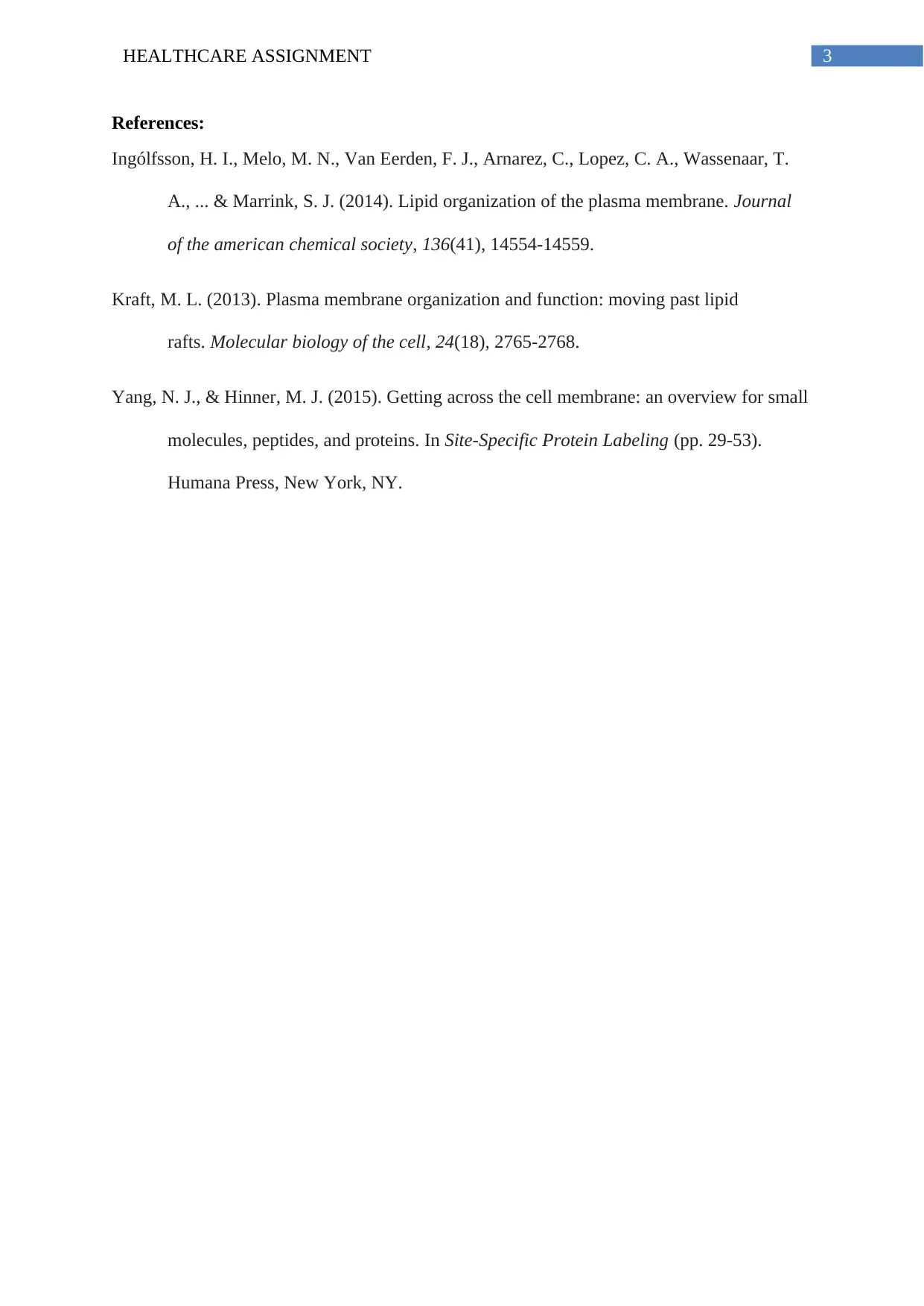Healthcare Assignment: Membrane Transport and Body Temperature
VerifiedAdded on 2023/04/21
|4
|662
|373
Report
AI Summary
This healthcare assignment delves into the structure and function of the plasma membrane, focusing on the fluid mosaic model and the transport of oxygen and sodium ions. It explains how oxygen diffuses across the membrane and details the sodium-potassium pump mechanism. Furthermore, the as...

Running head: HEALTHCARE ASSIGNMENT
HEALTHCARE ASSIGNMENT
Name of the Student:
Name of the University:
Author Note:
HEALTHCARE ASSIGNMENT
Name of the Student:
Name of the University:
Author Note:
Paraphrase This Document
Need a fresh take? Get an instant paraphrase of this document with our AI Paraphraser

1HEALTHCARE ASSIGNMENT
Plasma membrane:
Plasma membrane can be defined as the external cell boundary that separates the
content of the cell from the external cellular environment. The bi-lipid layer contains a
hydrophilic as well as a hydrophobic end. The hydrophilic ends of the bi-lipid layer is
positioned on the inner as well as outer surface of the membrane. On the other hand, the
hydrophobic ends are integrated deep inside the membrane (Kraft, 2013).
The structure of the plasma membrane can be explained with the help of fluid mosaic
model. The fluid mosaic model of the cell membrane was propounded by Singer and
Nicholson. The model is based upon the assumption that the phospholipid bilayer is made up
of an aggregate of hydrocarbons that make up the hydrophobic core of the plasma membrane.
The hydrophobic core restricts the diffusion of the water molecules from the membrane. The
tail from the polar head group is hydrophilic in nature and remains inside the membrane.
Transport of Oxygen across plasma membrane:
Gaseous diffusion occurs through the plasma membrane. The gases that are mainly
transported through the plasma membrane include, Oxygen, Carbon Dioxide and polar
molecules such as Urea and Ethanol. On account of the small molecular size, these gases do
not require a transport protein for the exchange. Also, the diffusion of these gaseous
molecules do not require metabolic energy expenditure. According to Ingólfsson et al.
(2014), the law of thermodynamics regulates the process. This can be explained by the fact
that the process leads to a positive change in the entropy and reflects a negative change in the
Gibbs free energy and therefore, the reaction can be mentioned to be spontaneous in nature.
Transport of Sodium across plasma membrane:
Sodium ions (Na+) and Potassium ions (K+) ions are transported together through the
Sodium Potassium pump which is also known as the P-class ion pump. The transport is
Plasma membrane:
Plasma membrane can be defined as the external cell boundary that separates the
content of the cell from the external cellular environment. The bi-lipid layer contains a
hydrophilic as well as a hydrophobic end. The hydrophilic ends of the bi-lipid layer is
positioned on the inner as well as outer surface of the membrane. On the other hand, the
hydrophobic ends are integrated deep inside the membrane (Kraft, 2013).
The structure of the plasma membrane can be explained with the help of fluid mosaic
model. The fluid mosaic model of the cell membrane was propounded by Singer and
Nicholson. The model is based upon the assumption that the phospholipid bilayer is made up
of an aggregate of hydrocarbons that make up the hydrophobic core of the plasma membrane.
The hydrophobic core restricts the diffusion of the water molecules from the membrane. The
tail from the polar head group is hydrophilic in nature and remains inside the membrane.
Transport of Oxygen across plasma membrane:
Gaseous diffusion occurs through the plasma membrane. The gases that are mainly
transported through the plasma membrane include, Oxygen, Carbon Dioxide and polar
molecules such as Urea and Ethanol. On account of the small molecular size, these gases do
not require a transport protein for the exchange. Also, the diffusion of these gaseous
molecules do not require metabolic energy expenditure. According to Ingólfsson et al.
(2014), the law of thermodynamics regulates the process. This can be explained by the fact
that the process leads to a positive change in the entropy and reflects a negative change in the
Gibbs free energy and therefore, the reaction can be mentioned to be spontaneous in nature.
Transport of Sodium across plasma membrane:
Sodium ions (Na+) and Potassium ions (K+) ions are transported together through the
Sodium Potassium pump which is also known as the P-class ion pump. The transport is

2HEALTHCARE ASSIGNMENT
guided by the expenditure of energy. The Na+/K+ ATPase in the E1 configuration comprises
of three high affinity Na atoms with binding site and two low affinity K atoms with the
binding site located at the cytosolic face of the membrane (Yang & Hinner, 2015) Therefore,
the transport of 3 Na atoms occur across the membrane which is guided by ATP expenditure.
The transport of the potassium ions inside the cell leads to the release of phosphate ions. The
phosphate ions are formed on account of the conversion of ATP molecules to ADP molecules
that occurs during the transport of the Na+ ions. It should be mentioned here that the
transport of the Na+ ions occurs with the help of a symporter which is a glucose molecule in
this case.
guided by the expenditure of energy. The Na+/K+ ATPase in the E1 configuration comprises
of three high affinity Na atoms with binding site and two low affinity K atoms with the
binding site located at the cytosolic face of the membrane (Yang & Hinner, 2015) Therefore,
the transport of 3 Na atoms occur across the membrane which is guided by ATP expenditure.
The transport of the potassium ions inside the cell leads to the release of phosphate ions. The
phosphate ions are formed on account of the conversion of ATP molecules to ADP molecules
that occurs during the transport of the Na+ ions. It should be mentioned here that the
transport of the Na+ ions occurs with the help of a symporter which is a glucose molecule in
this case.
⊘ This is a preview!⊘
Do you want full access?
Subscribe today to unlock all pages.

Trusted by 1+ million students worldwide

3HEALTHCARE ASSIGNMENT
References:
Ingólfsson, H. I., Melo, M. N., Van Eerden, F. J., Arnarez, C., Lopez, C. A., Wassenaar, T.
A., ... & Marrink, S. J. (2014). Lipid organization of the plasma membrane. Journal
of the american chemical society, 136(41), 14554-14559.
Kraft, M. L. (2013). Plasma membrane organization and function: moving past lipid
rafts. Molecular biology of the cell, 24(18), 2765-2768.
Yang, N. J., & Hinner, M. J. (2015). Getting across the cell membrane: an overview for small
molecules, peptides, and proteins. In Site-Specific Protein Labeling (pp. 29-53).
Humana Press, New York, NY.
References:
Ingólfsson, H. I., Melo, M. N., Van Eerden, F. J., Arnarez, C., Lopez, C. A., Wassenaar, T.
A., ... & Marrink, S. J. (2014). Lipid organization of the plasma membrane. Journal
of the american chemical society, 136(41), 14554-14559.
Kraft, M. L. (2013). Plasma membrane organization and function: moving past lipid
rafts. Molecular biology of the cell, 24(18), 2765-2768.
Yang, N. J., & Hinner, M. J. (2015). Getting across the cell membrane: an overview for small
molecules, peptides, and proteins. In Site-Specific Protein Labeling (pp. 29-53).
Humana Press, New York, NY.
1 out of 4
Related Documents
Your All-in-One AI-Powered Toolkit for Academic Success.
+13062052269
info@desklib.com
Available 24*7 on WhatsApp / Email
![[object Object]](/_next/static/media/star-bottom.7253800d.svg)
Unlock your academic potential
© 2024 | Zucol Services PVT LTD | All rights reserved.





